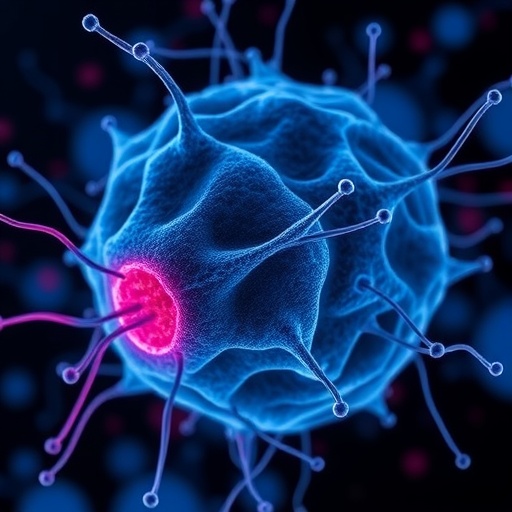Neuroblastoma, a formidable pediatric cancer, has long challenged clinicians and researchers alike due to its unpredictable nature and notorious resistance to conventional therapies. Strikingly, this malignancy exhibits a dual behavior: in around half of diagnosed cases, tumors regress spontaneously, yet in the remaining half, they proliferate aggressively, frequently returning despite initial chemotherapy response. A breakthrough study led by Jan Dörr and Anton Henssen at the Experimental and Clinical Research Center (ECRC) in Berlin sheds crucial light on the underlying mechanisms of neuroblastoma’s resiliency, revealing how the spatial organization of the notorious oncogene MYCN influences tumor behavior and therapeutic evasion.
Integral to neuroblastoma’s aggressiveness is the amplification of MYCN, an oncogene whose overabundance has been firmly linked to poor prognosis. However, the new research uncovers a pivotal nuance: not only the quantity of MYCN but its chromosomal or extrachromosomal location decisively affects tumor dynamics. Dörr and Henssen’s team discovered that when MYCN is housed within tiny, circular DNA fragments — so-called extrachromosomal DNA (ecDNA) rings — tumor cells demonstrate remarkable heterogeneity and adaptability. These ecDNA molecules distribute unevenly during cell division, resulting in subpopulations of cancer cells with varying MYCN copy numbers, a phenomenon that fuels tumor evolution and resistance.
The clinical implications are profound. While cells with high MYCN extrachromosomal copies exhibit rapid proliferation and are susceptible to chemotherapy, those with fewer copies adopt a dormant phenotype, entering a quiescent or “sleeping” state that shields them from cytotoxic treatments. This dormancy, characterized by distinct chromatin changes and altered protein expression profiles, essentially acts as a molecular sanctuary, permitting cancer cells to evade eradication. Once the therapeutic pressure subsides, these sleeping cells possess the ability to reawaken, driving tumor relapse and thwarting long-term remission.
This discovery was enabled by an innovative blend of spatial proteomics and cell-sorting techniques, allowing the researchers to dissect phenotypic and molecular differences between MYCN-high and MYCN-low cell populations. Collaborating closely with Dr. Fabian Coscia and his group at the Max Delbrück Center, the team employed a method hitherto unexplored in this context, enabling precise separation and characterization of these divergent cellular subsets. This technical advancement illuminated the adaptive heterogeneity intrinsic to neuroblastoma tumors driven by MYCN ecDNA.
In preclinical models, including cultured human tumor cells and mouse xenografts, the research demonstrated that conventional chemotherapy efficiently targets the proliferative MYCN-amplified cells, inducing cytotoxicity and tumor shrinkage. However, the dormant MYCN-low cells survive, effectively evading chemotherapy and serving as a reservoir for tumor regeneration. This insight reveals why neuroblastoma often recurs following initial treatment, highlighting a fundamental challenge in combating this disease: the coexistence of distinct tumor cell states within a single neoplasm.
Capitalizing on this knowledge, Dörr and colleagues explored therapeutic avenues aimed at eradicating dormant cancer cell populations. Encouragingly, drugs that selectively target senescent or quiescent cells—commonly referred to as senolytics—showed promise in preclinical experiments. When combined sequentially with standard chemotherapy, senolytic agents significantly improved treatment efficacy by eliminating the “sleeping” cells that would otherwise contribute to relapse. This combinatorial approach paves the way for a paradigm shift in treating MYCN-driven neuroblastomas.
Nevertheless, the team emphasizes that their innovative strategy is likely specific to tumors where oncogenes such as MYCN reside on extrachromosomal DNA. Tumors harboring traditional chromosomal amplifications may require alternative approaches. This distinction underscores the critical importance of genomic architecture in dictating tumor biology and therapeutic responsiveness, advocating for more personalized, genetics-informed cancer treatments.
Looking beyond neuroblastoma, the findings may have broad implications across oncology. Extrachromosomal DNA has been increasingly recognized in diverse cancers, including notoriously aggressive brain tumors. By unveiling the role of ecDNA-mediated oncogene heterogeneity in tumor adaptation and treatment resistance, this research opens avenues for investigating similar vulnerabilities in other malignancies that exploit this genomic mechanism.
At the heart of the study’s success lies a remarkable international collaboration spanning Germany, the United Kingdom, China, and the United States. Integrating clinical expertise from Charité – Universitätsmedizin Berlin with cutting-edge proteomics from the Max Delbrück Center and computational biology, the project exemplifies how multidisciplinary cooperation is paramount to tackling complex cancers. It also highlights the importance of robust funding partnerships, such as those provided by Cancer Research UK and the U.S. National Cancer Institute, under the Cancer Grand Challenges eDyNAmiC consortium.
The Max Delbrück Center for Molecular Medicine, renowned for its interdisciplinary and translational research, has played a pivotal role in advancing understanding of tumor heterogeneity and resistance mechanisms. Their expertise in spatial proteomics—a technique that maps protein distributions within tissues and cells—was instrumental in dissecting the functional landscapes of neuroblastoma subpopulations, thereby bridging molecular discoveries and therapeutic innovation.
As the study propels forward, the next frontier involves identifying and testing a broader spectrum of compounds capable of selectively annihilating dormant tumor cells while sparing healthy tissue. Achieving such precision will require sophisticated screening platforms and detailed molecular insights, but holds promise for drastically improving outcomes for pediatric patients afflicted by treatment-resistant neuroblastomas and potentially other ecDNA-positive cancers.
In sum, Dörr, Henssen, and their collaborators have not only delineated a previously unappreciated layer of complexity in MYCN-driven neuroblastoma but have also charted a scientifically grounded and promising route to circumvent the clinical obstacle posed by therapy-resistant dormant cells. Their work underscores the critical interplay between genomic architecture, cellular phenotypes, and therapeutic strategy, illuminating new horizons in pediatric oncology and beyond.
Subject of Research: Cells
Article Title: Extrachromosomal DNA-driven oncogene dosage heterogeneity promotes rapid adaptation to therapy in MYCN-amplified cancers
News Publication Date: 7-Aug-2025
Web References: 10.1158/2159-8290.CD-24-1738
Image Credits: © Giulia Montuori, Charité. The image was created with the help of the Advanced Light Microscopy Technology Platform of the Max Delbrück Center.
Keywords: neuroblastoma, MYCN, extrachromosomal DNA, tumor heterogeneity, therapy resistance, pediatric cancer, dormant tumor cells, senolytics, spatial proteomics, oncogene amplification, tumor relapse, cancer adaptation




